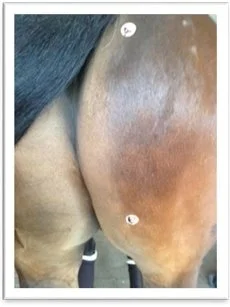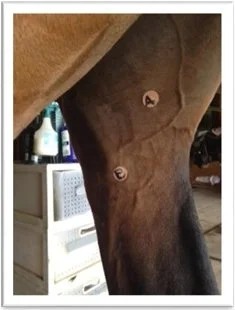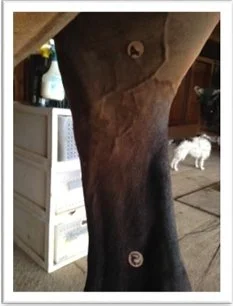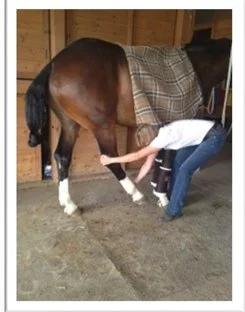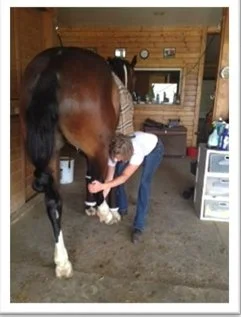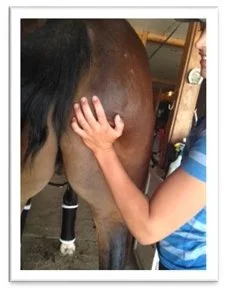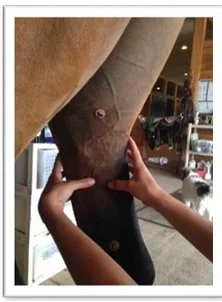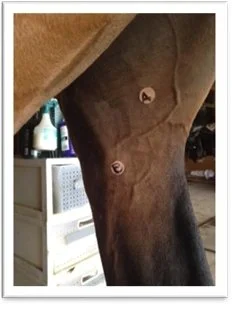Fibrotic Myopathy Rehab
Fibrotic myopathy in horses is a complex condition characterized by the formation of scar tissue in the muscles, most commonly affecting the hamstrings. This condition can lead to significant stiffness and a distinctive "goose-stepping" gait, which can be quite noticeable during movement. The onset of fibrotic myopathy is often attributed to trauma or repetitive strain, making certain breeds and activity levels more susceptible. While the prognosis is generally good for horses diagnosed with this condition, treatment options may vary and can include a combination of rest, various forms of physical therapy, or even surgical interventions in severe cases.
Laser:
Depending on the power of the laser, treat for a “chronic” condition based on laser settings. Recommended session progression: 3x/wk for 2 weeks 2x/wk for 2 weeks 1x/wk for 2 weeks After completing this cycle, use 1 – 4x/month based on activity level and mobility. If stiffness of gait returns after increasing workload, start cycle over again. Areas to laser are the semimembranosus and semitendinosus muscles of the hind end (See Photo: in general, Laser from A to B then repeat to left and right of this muscle). Both attach the pelvis to the hock for mobility. Laser these muscles from top to hock, specifically areas of greater density or tightness.
Stretch:
1. Lift hind leg and walk it forward directly under the body, keeping all joints in line at all times (do not pull leg outwards or push inwards).
2. Keeping yourself safe, pull limb forward towards heel of front hoof, keeping leg low to the ground
3. Slowly back yourself towards the front leg, pulling the hind limb with you, hold limb in a position that “points” hind toe to front heel.
4. Hold this position for 5-10 seconds minimum without struggle from the horse. You should feel the horse stretch into your hands as it seeks to push its toe to the ground. Keep hoof low to the ground until the horse understands the stretch. As flexibility returns, raise leg as you pull it forward (never higher than front pastern level). This increases the stretch and the difficulty.
5. This stretch can be done as frequently as 2-3x/day. DO BOTH HIND LEGS, not just the affected leg.
Massage:
At any point if the horse moves away or gets irritated, decrease pressure and go back to an area that was pleasant for him. Then work your way back into the tighter areas.
“Compression” – used to relax, spread, and compress tight muscle tissue and alleviate spasms. Using your palm or heel of your hand, slowly push inwards and upwards on the larger muscle bellies, you can add a twist as you work the larger muscle belly if you can manage it. Do not push on bony landmarks. Work up and down from tail head to above the hock on the inside and outside of the leg.
“Cross-Fiber Friction” – used to increase circulation, restore muscle mobility, break down adhesions and release myo-fascial constraint. Using thumbs, fingers, or knuckle, rub across the muscle fiber (so in the case of the hind end, you will be rubbing parallel to the ground across the muscles and tendons associated with the myopathy), increasing speed & pressure to create some heat in the area, then move on to the next point. Remember to rub the area inside the hock and up to the muscle belly of the gluteals.
Exercises:
Based on veterinarian’s timeline for work, add these exercises into the program.
1. Trot Poles: Start with 3-5 poles on the ground at walking distance apart (usually around 1.5-2’ depending on the horse). Walk/Ride over the poles at a walk intermittently during your workout. Slowly increase distance between the poles to force the horse to stretch and think about where the hind feet are landing. Eventually, do this at the trot as well.
2. Similar to the first exercise, set out 5 trot poles, this time starting at walking distance, mix up the distance between the poles – ie., set up the first two at walking distance, then the third almost 2.5’ apart, then narrow for pole #4, then wide for pole #5. Varying the distances will begin to re program muscle memory.
3. Use the end of the arena (riding area) to do mild bending. Set 3-4 poles in a quarter circle and walk over different areas each pass. Narrow towards the inside of the arena, wider towards the outside (another variation on breaking down muscle memory and stretching tendon fibers).
4. NO LATERAL work. When the limb begins to loosen, add in some bending by asking for hind to shift in or out based on direction and level of flexibility to get the horse to increase the stride and mobility. With all of these, be sure to do them in both directions to assist the horse in maintaining balance and symmetry.
Please note: these suggestions are not replacements for veterinary care. Please contact your veterinarian if there are changes in the horses condition or general rehabilitation timeline.
©Garnas Equine Therapeutic Services 2014
